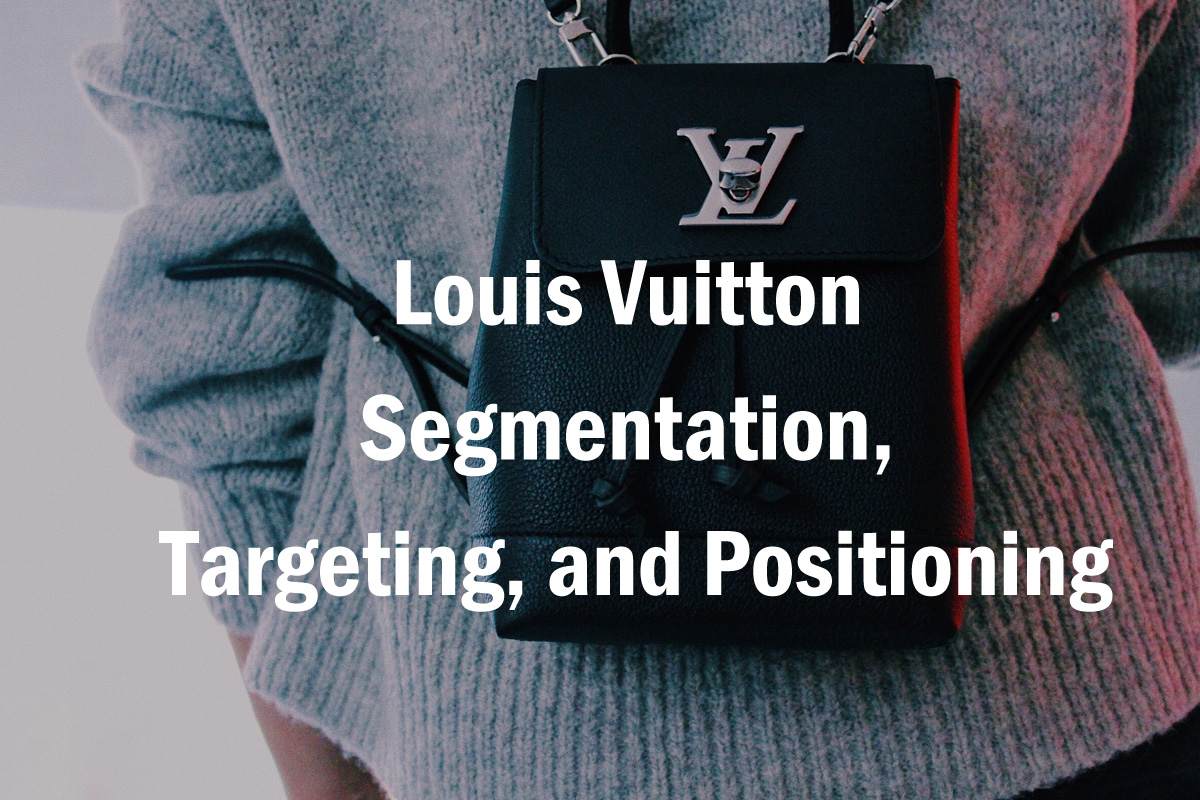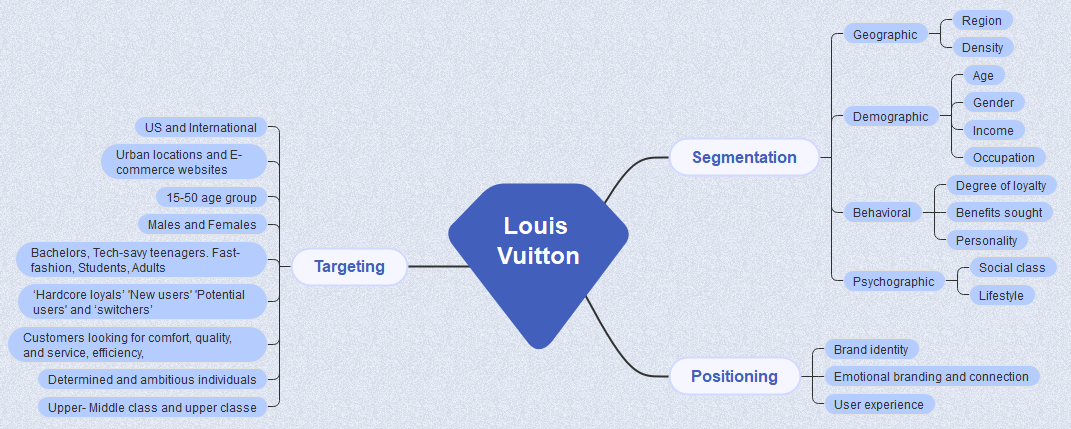Louis Vuitton Segmentation, Targeting, and Positioning
Discover More Helpful Information!
Welcome to EdrawMind!![]() Unleash your creativity and enhance productivity with our intuitive mind mapping software.
Unleash your creativity and enhance productivity with our intuitive mind mapping software.

1. Introduction
You may surely visit Louis Vuitton stores if you value the representation of the newest trends and originality, where you can discover the most delicate designs of shoes, leather clothing, purses, jewelry, and accessories, among other things. They are the most well-known and well-known luxury brands in the world. How did Louis Vuitton become so successful? Was it about properly implemented plans in all aspects of their businesses? Without a doubt. Let's talk about positioning tactics in general by looking at Louis Vuitton's marketing and targeting techniques.
Louis Vuitton, a luxury clothes and trendy accessories company founded in 1854, is the market leader in garments, ready-to-wear leather products, timepieces, footwear, accessories, and sunglasses. It works in far more than 60 countries throughout the world, with over 500 outlets in each of these countries. Louis Vuitton is a fashion-forward brand that employs a combination of demographic and psychographic segmentation tactics. LV has adopted a differentiating targeting approach to meet the evolving demands of its clients. It has always positioned its products as a sign of distinction and has earned a strong reputation throughout time. To attract potential clients in the market, LV employs value-based positioning methods.
2.Market Segmentation of Louis Vuitton
Louis Vuitton divides their customer base into demographic groups based on age, gender, and disposable income. Louis Vuitton specifically targets women aged 18 to 54 with high yearly salaries of $75,000 or more, indicating considerable discretionary money. To better define their target market, Louis Vuitton employs psychographic segmentations such as lifestyle and reasons. Louis Vuitton, for example, caters to jet setters, trendsetters, and those seeking prominence.
Louis Vuitton divides its customers into groups based on their usage habits, with heavy users receiving special attention. At the time of sale, buyer information is captured and stored in a database. To stimulate repeat brand image and brand loyalty, heavy users are provided seasonal catalogs as well as invites to purchase unique product collections.
Demographic Segmentation: It is a method of dividing people into groups based on their age. Louis Vuitton caters to both men and women, ages 16 to 80, who are rich. High-income and disposable-income businessmen and women.
Psychographic Segmentation: Louis Vuitton employs psychographic segmentation based on such as lifestyle and reasons. People in nations like China and Brazil must display their social rank and money. These clients are drawn to Louis Vuitton for status reasons. The next group is trendsetters and fashionistas. Louis Vuitton's ultimate strategy is lifestyle segmentation. "The Art of Traveling" became a new motto for a luxurious lifestyle. Because traveling is an art form, owning a Louis Vuitton item makes you a part of it.
Rate Segmentation-Usage: Louis Vuitton divides its customers into groups based on their usage habits, with heavy users receiving special attention. At the time of sale, buyer data is retrieved and stored in a database. To facilitate future sales and brand loyalty, heavy users are provided seasonal catalogs as well as invites to purchase unique product collections.
3. Targeting of Louis Vuitton
The rich middle-aged ladies from 35 to 54 years old are the first sector of Louis Vuitton's target market, while trendy young female adults from 18 to 34 years old who have saved enough money to buy one wish are the second. The average Louis Vuitton consumer is a high-level & social-class individual who is fashion-conscious. Possessing Louis Vuitton merchandise confers a high social prestige. Louis Vuitton places a premium on the material's quality, as well as the designs and craftsmanship of its goods. As a result, the product's cost price gradually skyrockets. Louis Vuitton adopts a premium pricing approach to price its items since the brand's target clientele are elite and upper-middle class. Customers are willing to pay high costs since the brand and its goods make a fashion statement.
Demographic segmentation was employed by Louis Vuitton to separate the market. It categorizes the market into several life phases based on age, gender, and income. Louis Vuitton has a distinct life stage in which its fashionable and high-quality clothing and accessories are worn by the wealthy and elite. Louis Vuitton's major target market is for wealthy people with a five-digit salary after required expenses have been paid and a home has been purchased.
4. Positioning of Louis Vuitton
Strategy Positioning is an important tool for every business to use when developing a marketing strategy. It infects the crucial marketing mix process, allowing a firm to obtain a competitive edge as well as a huge market share. As a result, it must be given top consideration while developing a marketing strategy. Furthermore, positioning is both an artistic expression that is critical to gaining and maintaining a customer's loyalty and trust. Typically, items are positioned according to the requirements and desires they frequently satisfy or the advantages they give to their respective clients.
In this perspective, it is clear that Louis Vuitton (LV) bases its product positioning on fashion and the most recent trends. Louis Vuitton's products are created with the newest market trends and current fashion in mind, allowing clients to discover the latest trend-based offerings and high-quality items. Louise Vuitton emphasizes exceptional quality, with an emphasis on long-term usage pleasure. There are several instances where retail firms unintentionally make defective items. In these situations, a high-priced product may appear useless, discouraging customers and leaving them unsatisfied. As a result, Louis Vuitton formed the Repair Service Sector.
5. Mind Map of LV Segmentation, Targeting, and Positioning
Consumers are ready to pay the price because they believe the company's items to be of great value. Louis Vuitton places a premium on the material's quality, as well as the designs and craftsmanship of its goods. As a result, the product's retail cost gradually skyrockets. Louis Vuitton adopts a premium pricing approach to price its items since the brand's target clientele are elite and upper-middle class. Customers are willing to pay high costs since the brand and its goods make a fashion statement.
There is a mind map aboutLV segmentation, targeting and positioning:

Whether for personal, educational, or professional use, an analysis template breathes life into ideas.🌱 Regardless of your purpose or project complexity, business analysis templates enhance clarity and manageability. Start using EdrawMind today for brilliance! 🦸
6. Key Takeaways
Louis Vuitton is one of the most prestigious and well-known fashion brands. Louis Vuitton, a leather designer, founded it in the year 1854. It was a pioneer in the fine leather business in the twentieth century. It has a network of more than 460 locations in 50 countries, specializing in high-end merchandise. From 2006 until 2012, it was ranked as the most established luxury company in the world.
Louis Vuitton has secured a distribution channel that is exclusive to them. Their goods aren't available in any department shops. The corporation is a firm believer in having its retail outlets. Louis Vuitton's highly educated salespeople are taught to handle their customers with great care. They serve their consumers with respect and provide them individual attention. Because they have a restricted number of stores, customers must walk up to them. Because the distribution chain is shorter, the corporation saves money by having fewer Louis Vuitton locations. You can also make a mind map like this or even better with EdrawMind. They have countless free pre-made templates for you to choose from and work your way within 5 minutes, even if you are a beginner.







